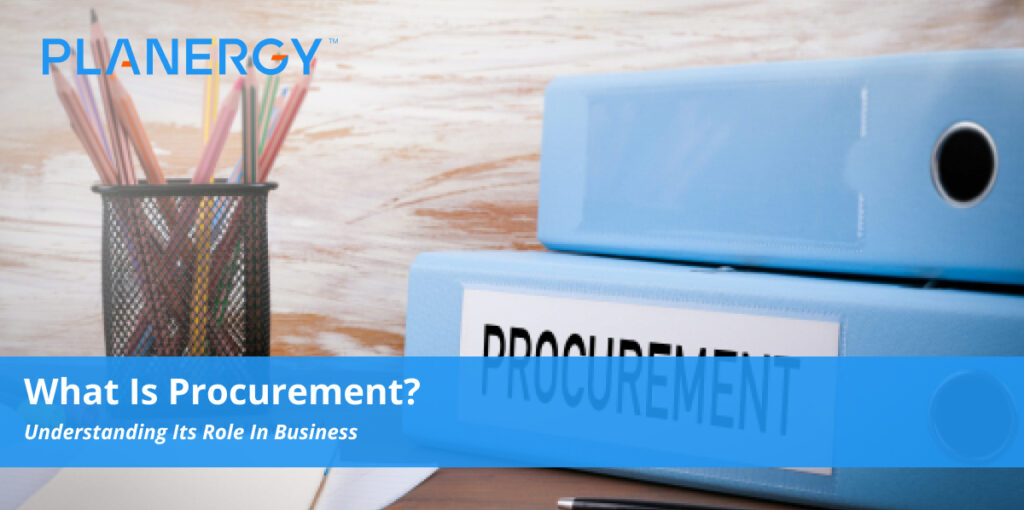Oftentimes, procurement and purchasing are used interchangeably.
Though most organizations understand the meaning, using the two terms in place of one another is technically incorrect.
What is Procurement?
Procurement is a purchasing process designed to control quality, quantity, sourcing, and timing, to ensure the organization achieves the best possible total cost of ownership.
Procurement looks different for every organization, and in certain industries, there are regulatory requirements that must be followed.
Purchasing is one area of procurement. Procurement involves multiple steps, where purchasing is the final step within the procurement process.
How Procurement Works
For smaller organizations, procurement may be as simple as creating a purchasing arrangement with a supplier.
But for larger organizations with multiple departments and locations to manage, it becomes far more complex.
The arrangements made with vendors throughout the supply chain are more detailed, including quality, quantity, and delivery requirements based on the production process.
Procurement has multiple stages, after the need for a new product or service has been recognized, many of which are associated with strategic sourcing.
Information Gathering
In this stage, the procurement team gathers information to determine who potential suppliers are.
You should know exactly what you need, and define the business requirements, along with the vendor requirements before you begin your search.
As you search, narrow down the list of vendors only to those you are interested in working with based on how well they meet your requirements.
Supplier Contacts
In this stage, the team gathers the contact information for each of the potential supplies they are considering working with.
Many organizations gather the information they need by sending a request for information (RFI) to the short-listed vendors.
Background Reviews
In this step, vetting, screening, and checking references occurs, using the information the vendors provided in response to your RFI.
Based on your evaluation of the responses, you’ll narrow your list even further.
Negotiations
At this point, the ideal suppliers have been chosen, and it’s time to work to get the best possible deal. At this point, is where prices and terms of the deal are set.
The final vendor isn’t necessarily selected at this point, because it’s highly possible to be in negotiations with multiple suppliers, and then choose the one that will provide the best terms at the best price.
You’ll write a Request for Proposal (RFP) or Request for Quotation (RFQ). Regardless of chosen formation, you’ll need to include:
- Submission details
- Induction with executive summary
- Business overview and background
- Detailed specifications
- Any assumptions and constraints
- Terms and conditions
- Selection criteria
Then, you’ll evaluate all the proposals you get back and choose the vendor to sign a contract with.
During this evaluation and selection process, you’ll record requirements for both your business and the vendor.
Then you’ll assign an importance value and a performance value for each requirement.
From there, you’ll calculate the total score and choose the winning bidder.
That’s who you’ll enter formal negotiations with to finalize the details of the contract.
Ordering
Once your organization has a list of approved vendors for the various raw materials, goods, and services you require, entering all the information into an e-procurement system further streamlines the process.
Require your team to use a formal purchase request that details the vendor, the goods or services to be ordered, the cost, and so on, to ensure the department has the necessary budget.
Those requests should be automatically forwarded to a department head or other decisionmaker within the organization, who can approve them.
Once approved, the purchase requisition converts to a purchase order, which is sent to the vendor.
Fulfillment
This stage involves delivery of the items, or the completion of installation, etc. of the goods or services that were ordered.
Consumption, Maintenance, Disposal
In this stage, the organization is monitoring the actual delivery and use of the supplies or equipment ordered.
With three-way matching, the e-procurement system matches the purchase order to the vendor invoice, to the receipt of goods.
This process ensures your organization only pays for goods you ordered, and goods you received, to avoid wasted spend.
Renewal
In this stage, the organization is placing additional orders and continuing their relationship with the supplier.
Direct procurement systems involve integrating purchasing into the company’s supply chain management system to ensure the right supplies are delivered at the right time.
In manufacturing systems, this approach is known as “just-in-time” and is designed to minimize inventory holding costs and continue steady delivery of the supplies needed in the production process.
Why Procurement Matters
Within your organization, going beyond purchasing to develop a procurement process ensures your purchasing is fair, competitive, and provides the best possible prices in the market.
With a formal procurement process, the company operates at increased efficiency.
This makes procurement an important component of your company’s overall management structure.
Some problems with cash flow and the balance sheet can be traced to issues with procurement, including holding inventory and supplies too long, and having the terms of payables for supplies misaligned to their respective receivables.
Solid procurement management involves maintaining quality supplier relationships and inventory control, regardless of the business model.
By changing the way your company handles purchasing everything – from office supplies to heavy equipment, you can maximize your efficiency, improve productivity, reduce indirect spend, and ultimately see bigger profits.




